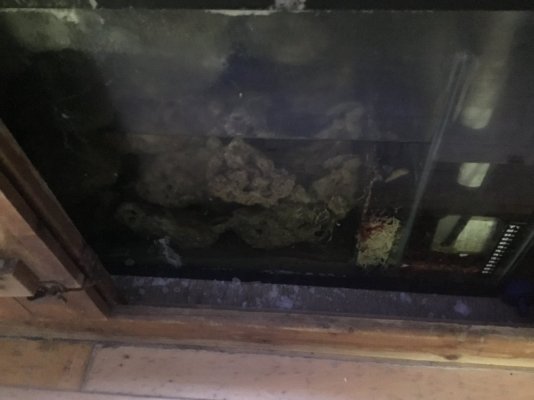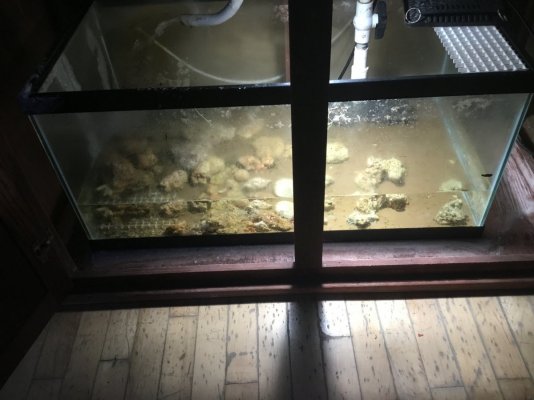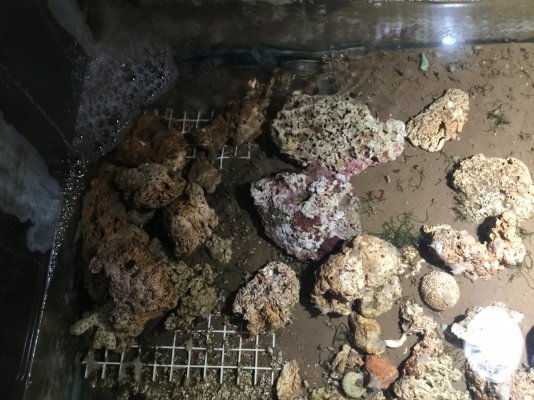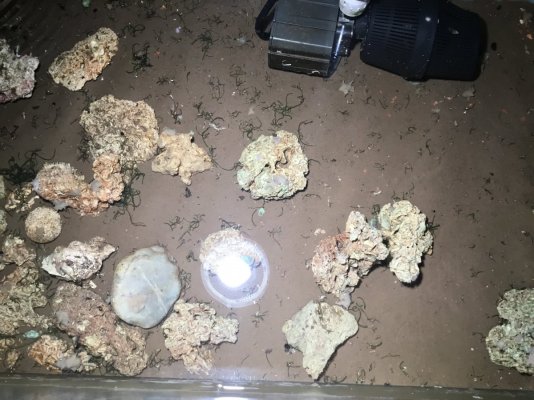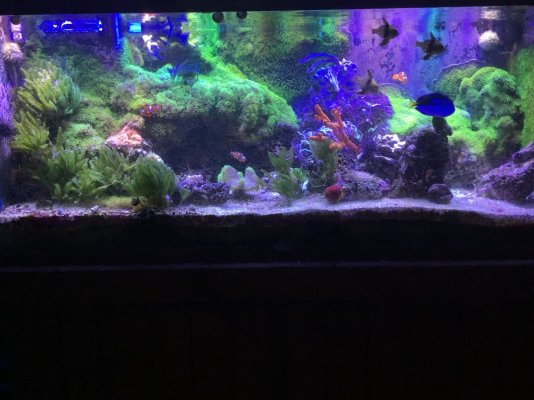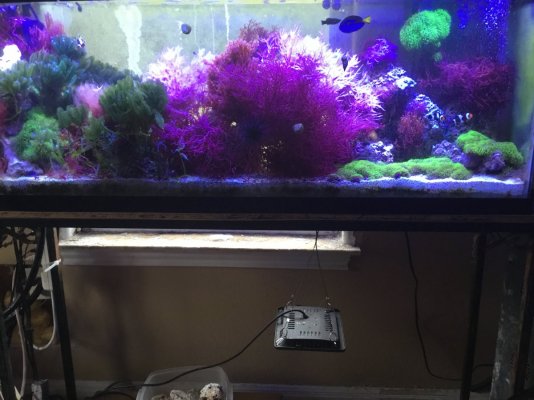Bump
Navigation
Install the app
How to install the app on iOS
Follow along with the video below to see how to install our site as a web app on your home screen.
Note: This feature may not be available in some browsers.
More options
You are using an out of date browser. It may not display this or other websites correctly.
You should upgrade or use an alternative browser.
You should upgrade or use an alternative browser.
A Seagrass and Deep Sand Bed Theory...
- Thread starter WheatToast
- Start date
- Tagged users None
Bump
Could seagrasses be the solution to deep sand bed issues?
@WheatToast
Why the focus on DSB? What benefit do you seek? After 50yrs of Reefing, I have seen successful displays with every method imaginable ranging from highly instrumented ULNS systems to high nutrient macro/seaweed minimalist lagoons. I prefer the latter.
I operated a 75G Jaubert Plenum with 6”DSB for 20 yrs, on bottom was 30G mud macro refugium. In the last 5 yrs, I siphoned out 200 lbs of sand bed down to 2” and modified Jaubert Plenum into reverse flow undergravel filter. The mud macro refugium was converted to cryptic refugium by removing lights and adding mature live rock from established tanks.
My goal as a minimalist is to use biochemistry of bacteria, algae and cryptic sponges to maintain a biodiverse system using Dynamic Equilibrium with nutrient recycling as the mainstay of nutrient management in ornamental seaweed tanks.
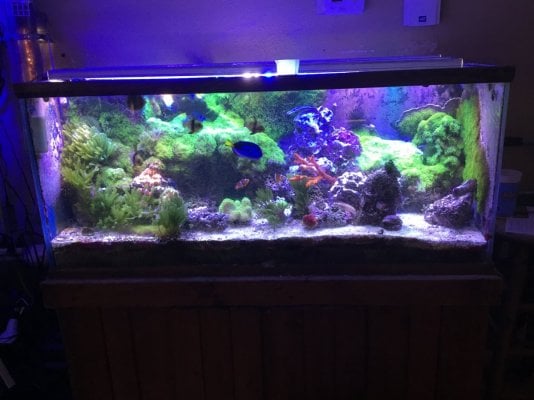
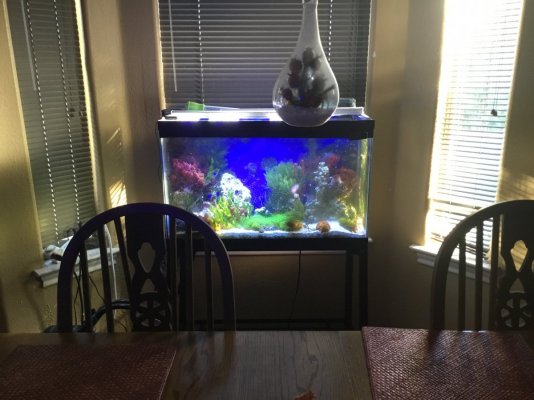
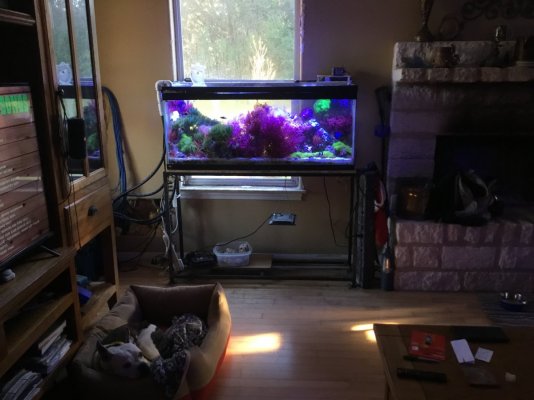
@WheatToast
Why the focus on DSB? What benefit do you seek? After 50yrs of Reefing, I have seen successful displays with every method imaginable ranging from highly instrumented ULNS systems to high nutrient macro/seaweed minimalist lagoons. I prefer the latter.
I operated a 75G Jaubert Plenum with 6”DSB for 20 yrs, on bottom was 30G mud macro refugium. In the last 5 yrs, I siphoned out 200 lbs of sand bed down to 2” and modified Jaubert Plenum into reverse flow undergravel filter. The mud macro refugium was converted to cryptic refugium by removing lights and adding mature live rock from established tanks.
My goal as a minimalist is to use biochemistry of bacteria, algae and cryptic sponges to maintain a biodiverse system using Dynamic Equilibrium with nutrient recycling as the mainstay of nutrient management in ornamental seaweed tanks.



Unrelated question, but I saw in your picts your growing ornamental sponges. Id really like to try my hand at them. Do you have any tips/ tricks as to their care.
Could seagrasses be the solution to deep sand bed issues?
@WheatToast
Why the focus on DSB? What benefit do you seek? After 50yrs of Reefing, I have seen successful displays with every method imaginable ranging from highly instrumented ULNS systems to high nutrient macro/seaweed minimalist lagoons. I prefer the latter.
I operated a 75G Jaubert Plenum with 6”DSB for 20 yrs, on bottom was 30G mud macro refugium. In the last 5 yrs, I siphoned out 200 lbs of sand bed down to 2” and modified Jaubert Plenum into reverse flow undergravel filter. The mud macro refugium was converted to cryptic refugium by removing lights and adding mature live rock from established tanks.
My goal as a minimalist is to use biochemistry of bacteria, algae and cryptic sponges to maintain a biodiverse system using Dynamic Equilibrium with nutrient recycling as the mainstay of nutrient management in ornamental seaweed tanks.



Actually, your question is not unrelated. To grow ornamental sponges, flame scallops & sea apples as well as coral. I focus on recycling nutrients into live food. To accomplish that, I focus on micro fauna & fana in sandbed to process inorganic & organic nutrients into live food and in cryptic refugium DOC is processsed to become detritus which feeds the microbial loop moving carbon up the food chain.Unrelated question, but I saw in your picts your growing ornamental sponges. Id really like to try my hand at them. Do you have any tips/ tricks as to their care.
On my oldest system with a mud/macro filter, the depth increased from .5” - 1” in 25 yrs and feels spongy to the touch.

Build Thread - 25 year old 75G Jaubert Plenum on top with 30G EcoSystem Mud/Macro
The tank has seen little change in 25 years. Jaubert Plenum was designed to use facultative bacteria in a low oxygen environment to perform denitrification biochemistry. Substrate was 6” deep with false bottom making a Plenum under substrate. Plenum performed well until the introduction of...
 www.reef2reef.com
www.reef2reef.com
***. sponges require silicates
Can you post a FTS of your sump? I'd like to see how you designed it. From the sounds of it, This filter might be exactly what I'm looking to re-create.Actually, your question is not unrelated. To grow ornamental sponges, flame scallops & sea apples as well as coral. I focus on recycling nutrients into live food. To accomplish that, I focus on micro fauna & fana in sandbed to process inorganic & organic nutrients into live food and in cryptic refugium DOC is processsed to become detritus which feeds the microbial loop moving carbon up the food chain.
On my oldest system with a mud/macro filter, the depth increased from .5” - 1” in 25 yrs and feels spongy to the touch.

Build Thread - 25 year old 75G Jaubert Plenum on top with 30G EcoSystem Mud/Macro
The tank has seen little change in 25 years. Jaubert Plenum was designed to use facultative bacteria in a low oxygen environment to perform denitrification biochemistry. Substrate was 6” deep with false bottom making a Plenum under substrate. Plenum performed well until the introduction of...www.reef2reef.com
***. sponges require silicates
Pictures are awkward to take in 30G Ecosystem mud/macro system. Refugium is 30” long with three sections: section 1 is 6” wide filled with reef rubble that provides robust gas exchange & breaks up detritus to settle in 24” wide mud filter with mature live rock on eggcrate grid, section 3 is pump out.
on 5 yr old 120G tank cryptic refugium is a 40G breeder. Note: this refugium has room for much more live rock.
on 5 yr old 120G tank cryptic refugium is a 40G breeder. Note: this refugium has room for much more live rock.
Attachments
so, you put LR in the sump. and then have the "MUD" in the second chamber along with some other LR? How thick is the "MUD" and are the rocks exposed to air or are they completely submerged?Pictures are awkward to take in 30G Ecosystem mud/macro system. Refugium is 30” long with three sections: section 1 is 6” wide filled with reef rubble that provides robust gas exchange & breaks up detritus to settle in 24” wide mud filter with mature live rock on eggcrate grid, section 3 is pump out.
on 5 yr old 120G tank cryptic refugium is a 40G breeder. Note: this refugium has room for much more live rock.
First off, awesome looking builds! The window aesthetic looks so cool!Could seagrasses be the solution to deep sand bed issues?
@WheatToast
Why the focus on DSB? What benefit do you seek? After 50yrs of Reefing, I have seen successful displays with every method imaginable ranging from highly instrumented ULNS systems to high nutrient macro/seaweed minimalist lagoons. I prefer the latter.
I operated a 75G Jaubert Plenum with 6”DSB for 20 yrs, on bottom was 30G mud macro refugium. In the last 5 yrs, I siphoned out 200 lbs of sand bed down to 2” and modified Jaubert Plenum into reverse flow undergravel filter. The mud macro refugium was converted to cryptic refugium by removing lights and adding mature live rock from established tanks.
My goal as a minimalist is to use biochemistry of bacteria, algae and cryptic sponges to maintain a biodiverse system using Dynamic Equilibrium with nutrient recycling as the mainstay of nutrient management in ornamental seaweed tanks.



Second, I am not focusing on the effectiveness of DSB’s (this applies to you @zoa what with your previous post here as well). I am just writing this thread to detail a theory that could work with DSB’s, for anyone who wants to try them. Plus, DSB’s support their own unique organisms and aesthetics that other setups could not.
“Plus, DSB’s support their own unique organisms and aesthetics that other setups could not.”
MAYBE TRUE. I assure you, it’s not so simple.
In my experiences with 20 years of maintaining deep sand beds, I saw no real biodiversity in the anoxic sections, mostly reducing bacteria like denitrification or sulfide reducing.
MAYBE TRUE. I assure you, it’s not so simple.
In my experiences with 20 years of maintaining deep sand beds, I saw no real biodiversity in the anoxic sections, mostly reducing bacteria like denitrification or sulfide reducing.
Last edited:
so, you put LR in the sump. and then have the "MUD" in the second chamber along with some other LR? How thick is the "MUD" and are the rocks exposed to air or are they completely submerged?
I have two different systems: 30G EcoSystem mud/macro refugium converted to cryptic refugium 5 yrs ago and 40G breeder set up as cryptic refugium 5 yrs ago.. Initially, mud macro section had 1/2“ of miracle mud 25 yrs ago. Over the yrs, detritus increased depth to 1” that feels spongy to the touch. I used eggcrate spacers to lift rock out of mud. All rocks are submerged except for some of the rubble in first compartment of ecosystem filter which was called wet/dry compartment. The goal in this compartment is to provide robust gas exchange as water tumbles down on rocks and to break up detritus as it settles into mud compartment.
This is the best description of biofiltration in dsb that I have found.
If you want to grow true sea plants, a deep sandbed is required. Because sea grass tanks are harder to start up, I left them for ornamental seaweed lagoons. With a 2” aroggonite Sandbed, that is oxygenated with reverse flow undergravel filter, maximum diversity of micro fauna & fana is achieved.
with respect to early reef aquarium methods, DSB was used to produce anoxic bacteria that performed denitrification
What is a deep sand bed?
A deep sand bed is a sand substrate coupled with bacteria and multicellular organisms working together as a powerful biological filter. Originally developed in the saltwater aquarium hobby, deep sand beds (DSBs) extended the biological filter from converting ammonia and ammonium to nitrate, to eliminating nitrate by denitrification - using the oxygen in nitrate, releasing harmless nitrogen or nitrous oxide. This was desirable because of saltwater organisms’ great sensitivity to nitrate. In freshwater, nitrates are much less toxic, requiring infrequent water changes to control levels, but the freshwater DSB as described in this article does more than eliminate nitrate.
How does the Freshwater DSB work? What does it do?
Primarily, freshwater DSBs are biological filters, eliminating ammonia, nitrite, nitrate, hydrogen sulfide, byproducts of decay, and solid waste (mulm). Secondarily they are good planting mediums because decaying organic matter disintegrates and sifts into the sand, releasing carbon dioxide and minerals which boost plant health and growth.
Root feeding plants are going to take up nutrients from the substrate so yeah I think it would help. Will Vallisneria grow in saltwater? I’ll send you some 

do you still have this system with the reverse undergravel filter still setup?
This is the best description of biofiltration in dsb that I have found.
If you want to grow true sea plants, a deep sandbed is required. Because sea grass tanks are harder to start up, I left them for ornamental seaweed lagoons. With a 2” aroggonite Sandbed, that is oxygenated with reverse flow undergravel filter, maximum diversity of micro fauna & fana is achieved.
with respect to early reef aquarium methods, DSB was used to produce anoxic bacteria that performed denitrification
What is a deep sand bed?
A deep sand bed is a sand substrate coupled with bacteria and multicellular organisms working together as a powerful biological filter. Originally developed in the saltwater aquarium hobby, deep sand beds (DSBs) extended the biological filter from converting ammonia and ammonium to nitrate, to eliminating nitrate by denitrification - using the oxygen in nitrate, releasing harmless nitrogen or nitrous oxide. This was desirable because of saltwater organisms’ great sensitivity to nitrate. In freshwater, nitrates are much less toxic, requiring infrequent water changes to control levels, but the freshwater DSB as described in this article does more than eliminate nitrate.
How does the Freshwater DSB work? What does it do?
Primarily, freshwater DSBs are biological filters, eliminating ammonia, nitrite, nitrate, hydrogen sulfide, byproducts of decay, and solid waste (mulm). Secondarily they are good planting mediums because decaying organic matter disintegrates and sifts into the sand, releasing carbon dioxide and minerals which boost plant health and growth.
I'd be curious as to how that looks.
I know back in the day under gravel filters where the thing to use in the FW aquaria.
do you still have this system with the reverse undergravel filter still setup?
I'd be curious as to how that looks.
I know back in the day under gravel filters where the thing to use in the FW aquaria.
I have three RFUGF in operation for 5 years and one 6 month systems. I consider the plenum void to be a high flow cryptic refugium and the oxygenated sand bed to be a Biofilter that converts organic & inorganic nutrients into live food for hungry mouths.
Talk with @Paul B, his system is 50 yrs old.
Last edited:
Anyone know if eelgrass ( Zostera) will stay alive at reef temps? I'm allowed to collect uprooted seagrass at or above the high tide mark. I want to try this but dont know if any of my native seagrasses would stay alive
Last edited:
First picture is 25 yr setup. Second picture is 6 month set up.do you still have this system with the reverse undergravel filter still setup?
I'd be curious as to how that looks.
I know back in the day under gravel filters where the thing to use in the FW aquaria.
Attachments
Can you post a FTS of your sump? I'd like to see how you designed it. From the sounds of it, This filter might be exactly what I'm looking to re-create.
In smaller tank I use cannister filters as high flow cryptic refugiums.
Root feeding plants are going to take up nutrients from the substrate so yeah I think it would help. Will Vallisneria grow in saltwater? I’ll send you some

send me some Vallisneria. I used C. Prolifera to simulate ell grass in my lagoon setups, but I found it’s holdfast roots unacceptable in my sandbeds.
I will send you some dragons breath or red grapes.
This is a freshwater tank, with freshwater plants. If you want to trade some saltwater macro for my freshwater plants I’d be open to it, but i want to make sure we understand each other lol.send me some Vallisneria. I used C. Prolifera to simulate ell grass in my lagoon setups, but I found it’s holdfast roots unacceptable in my sandbeds.
I will send you some dragons breath or red grapes.
Similar threads
- Replies
- 4
- Views
- 121
- Replies
- 1
- Views
- 126
- Replies
- 84
- Views
- 4,331
- Replies
- 4
- Views
- 430





